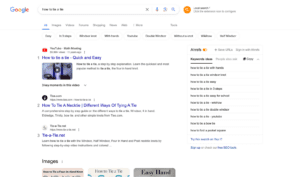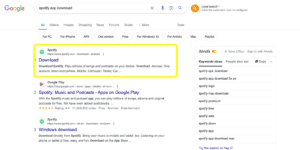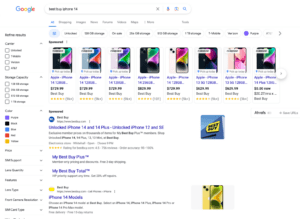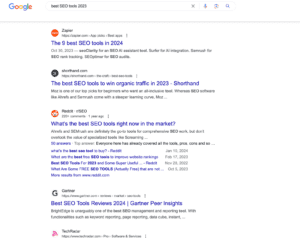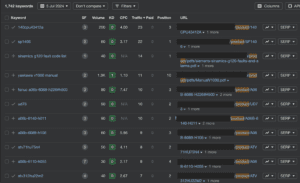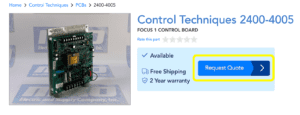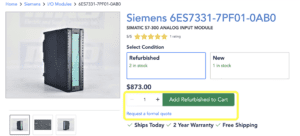Table of Contents
Have you ever wondered what makes some search results more relevant than others? The secret lies in search intent—the reason behind every query a user searches. Aligning your content with users’ search intent not only boosts your visibility but also enhances user engagement. In this article, we’ll delve into the different types of search intent, how you can identify them, and how they can transform your SEO strategy and content development.
What is Search Intent?
Search intent, or user intent, is the motivation behind every search query entered into a search engine. What drives someone to type those particular words? Are they seeking information, trying to make a purchase, or looking for a specific website? Understanding search intent is crucial for SEO because it influences how well your content performs in search rankings and how visitors interact with your site.
Google’s algorithms have evolved to prioritize websites that best match not only the keywords but also the intent behind the queries. This focus on search intent means Google aims to list content that aligns most closely with what the searcher is actually seeking.
For example, if a user searches “how to install a ceiling fan,” they are likely looking for a detailed guide or instructional video, indicating informational intent. Knowing this, your content should provide comprehensive, step-by-step installation instructions to rank well in search engine results pages (SERPs).
Why is Search Intent Important for SEO?
Google’s top priority is to provide users with the most relevant and helpful results for their searches. By understanding and aligning with search intent, you can create content that not only ranks higher but also truly satisfies your visitors.
Imagine Google as a matchmaker between users and the information they’re seeking. If your content matches the user’s intent, Google is more likely to show it at the top of the search results. This means more visibility for you and a better experience for your audience.
For instance, when someone searches for “best SEO tools 2023,” they’re probably looking to compare options before making a decision. If your content offers detailed comparisons and honest reviews, you’re directly addressing their needs.
For more insights into how search intent can impact your keyword rankings, check out this detailed article.
The Types of Search Intent For SEO
Search intent can be categorized into four buckets: informational, navigational, transactional, and commercial investigation. Here’s a breakdown of each type and how they differ from one another:
1. Informational Intent
Informational intent is when searchers are primarily looking to learn or gather information without any immediate intention of making a purchase.
For example, if someone searches for “how to tie a tie,” they are seeking knowledge. Your content for these queries should be informative and clearly answer the questions posed.
2. Navigational Intent
Navigational intent means the user is trying to reach a specific website or webpage. A typical query might be “Twitter login” or “Spotify app download.” Here, the searcher knows their destination and uses the search engine as a shortcut. Your goal should be to facilitate their navigation by ensuring that your site is optimally structured to lead them to their intended target quickly.
3. Transactional Intent
Transactional intent is when the searcher’s goal is to perform some type of transaction, such as making a purchase or signing up for a service. Searches like “best buy iphone 14” or “buy ceiling fans” clearly indicate this intent. To cater to these users, your content should include strong calls to action and a streamlined purchasing process that makes it easy to transition from interest to action.
4. Commercial Intent
Commercial intent is for searchers who are on the brink of making a purchase but are still comparing options or looking for the best deal. This intent is seen in queries such as “best SEO tools 2023” or “Samsung vs. iPhone reviews.” These users are looking for detailed comparisons and reviews to help them make informed purchasing decisions.
Identifying Search Intent
How can you tell what users really want from their search queries? Start with these strategies:
1. SERP Analysis:
Look at the current top results for a keyword. What do they suggest about user expectations? If the top results are how-to guides, it’s likely that users are looking for informational content. On the other hand, if the results are product pages or reviews, the intent might be a transactional or commercial investigation. Analyzing the SERPs can give you a clear idea of what type of content Google believes best serves the user intent for that keyword.
2. Keyword Modifiers:
Pay attention to words that modify searches, such as “how to,” “buy,” or “review.” These types of queries can indicate the intent behind the search. For example, a query like “how to bake a cake” suggests informational intent, while “buy iPhone 12” indicates transactional intent. Here are some common modifiers to look out for:
- how to – informational
- best – commercial
- buy – transactional
- reviews – commercial
- cheap – transactional
- top – commercial investigation
- guide – informational
- benefits of – informational
- vs – commercial investigation
- near me – transactional
3. Analytics:
Dive into your site analytics. Which articles perform best, and what does this tell you about your visitors’ intentions? By examining which pages have the most engagement and conversions, you can infer the search intent behind the keywords driving traffic to those pages. This data can guide you in optimizing existing content and creating new content that aligns with user intent.
How To Optimize Content for Search Intent
When creating or optimizing content, it’s important to align with the search intent of your audience. This will ensure that your pages effectively meet their needs. There are many techniques you can use to optimize content depending on the intent of the page. Let’s dive into some strategies for optimizing content to match different types of search intent.
Optimizing for Informational Intent
When optimizing for informational intent, focus on providing clear, authoritative answers to users’ questions. Popular content formats for meeting this intent include:
- Blogs and Articles: These should thoroughly cover topics relevant to your audience’s queries.
- Guides and Tutorials: In-depth and step-by-step formats work best for those seeking comprehensive information on a subject.
- Videos: Ideal for users who prefer visual and auditory learning. Make sure they are well-captioned and structured to address specific questions throughout the video.
Use natural language keywords and questions as headers to improve SEO and ensure your content directly addresses users’ needs.
Optimizing for Navigational Intent
Users with navigational intent know where they want to go; they just need help getting there. Ensure your brand and product names are prominently featured across your site, particularly in:
- Page Titles and Meta Descriptions: Make them clear and accurate to improve visibility in search results.
- Header Tags: Including branded keywords in H1 or H2 tags can help with page ranking for navigational searches.
Make sure your internal linking is robust enough to guide users effortlessly through your site.
Optimizing for Transactional Intent
For transactional intent, your goal is to facilitate a smooth and straightforward path to conversion. Here are some key strategies:
- Clear Calls to Action (CTAs): Ensure your CTAs are prominent and compelling, guiding users to make a purchase or sign up.
- Streamlined Checkout Processes: Simplify the steps required to complete a transaction to reduce cart abandonment.
- Trust Signals: Include customer reviews, security badges, and guarantees to build trust and encourage conversions.
Optimizing for Commercial Investigation
When users are in the commercial investigation phase, they are comparing options before making a purchase decision. Your content should help them make an informed choice by including:
- Comparative Content: Create side-by-side comparisons of your products versus competitors.
- Detailed Product Reviews: Offer in-depth reviews and analyses of your products.
- User Testimonials: Showcase positive experiences from satisfied customers to build credibility and trust.
Examples of Successful Search Intent SEO
Let’s dive into a real-world example to illustrate how understanding search intent can significantly impact SEO and user experience. One of my clients is a factory automation wholesale distributor who sells industrial automation parts. Their main audience consists of experts in the field who are potentially looking for replacement parts or repairs for their automation systems.
Identifying Transactional Intent
After analyzing the keywords my client was ranking for, I discovered that many of them had transactional intent. It appeared that in this industry, users often search for specific product names or numbers, indicating that they’re ready to purchase a particular product immediately.
With this discovery, we decided to look at different methods to streamline and enhance the current checkout process.
Original Setup: Request a Quote
Originally, the checkout process on my client’s website required users to ‘Request a Quote’ for every product. Users had to get in contact with my client via a ‘Request a Quote’ button and form, or they could call or email. There was no way for users to go through the checkout process themselves and purchase a product directly through the website without talking to a representative. This extra step could deter users who were ready to buy on the spot.
Streamlined Checkout Process
To better align with the identified transactional intent, we introduced a new checkout method that allows users to add products to a cart and checkout on their own. We still maintained the ‘Request a formal quote’ option and ensured the ‘Contact Us’ link was prominently displayed in the main header for users who had questions.
SEO and Search Intent Benefits
By streamlining the checkout process, we effectively catered to the transactional intent of our audience. This change is expected to have several positive outcomes:
- Improved User Experience: By reducing friction in the purchasing process, we enhance the user experience, making it easier for customers to complete their purchases.
- Increased Conversions: A smoother checkout process can lead to higher conversion rates, as users are less likely to abandon their purchase due to a cumbersome process.
- Higher Search Rankings: Search engines prioritize sites that provide a seamless user experience. By aligning our content and checkout process with the transactional user intent, we improve our chances of ranking higher in search results.
- Engaged Audience: Providing a clear path to purchase helps meet the immediate needs of users, increasing satisfaction and the likelihood of repeat visits.
By understanding and optimizing for transactional intent, we ensured that our content and user experience were perfectly aligned with what our audience was looking for, ultimately driving more traffic and conversions.
Challenges in Understanding and Applying Search Intent
Understanding and applying search intent can be challenging for marketers. Here are some common hurdles and how to overcome them:
Ambiguous Queries
One of the biggest challenges is dealing with ambiguous queries. These are search terms that are not clearly defined and can have multiple meanings. For example, a query like “apple” could refer to the fruit, the tech company, or even a music band.
Solution: To handle ambiguous queries, perform a thorough SERP analysis to see what type of content is ranking. This can give you insight into what most users are looking for. Additionally, consider creating content that addresses multiple interpretations, or use modifiers to clarify the intent in your keywords, like “Apple fruit nutrition” vs. “Apple iPhone features.”
Overlapping Intents
Sometimes, a single query can have overlapping intents. For instance, a search for “best DSLR camera” might have both informational intent (looking for reviews) and transactional intent (ready to purchase).
Solution: Create comprehensive content that serves multiple intents. For the example above, a blog post that includes detailed reviews, comparison charts, and direct purchase links can cater to both informational and transactional intents. Structured content with clear sections can help users quickly find what they are looking for.
Changing User Behavior
User behavior and search patterns can change over time, making it difficult to maintain alignment with search intent. What worked well a year ago might not be effective today.
Solution: Regularly review your analytics and perform periodic keyword research to stay updated on current trends and user behavior. Adapt your content strategy based on these insights to ensure you are meeting the evolving needs of your audience.
Limited Data
For niche markets or new websites, there might be limited data available to accurately determine search intent. This can make it difficult to create content that aligns well with user needs.
Solution: In such cases, leverage competitor analysis to gather insights on what’s working well in your industry. Look at the content and keywords your competitors are using and how they address user intent. Also, consider using surveys or feedback forms to ask your audience about their needs and preferences directly.
Balancing SEO and User Experience
Sometimes, optimizing for search engines can conflict with creating a seamless user experience. For example, stuffing a page with keywords might improve rankings but could make the content less readable.
Solution: Focus on creating high-quality, user-centric content that naturally incorporates relevant keywords. Use clear headings, bullet points, and concise paragraphs to improve readability. Remember that search engines are increasingly prioritizing user experience in their ranking algorithms.
By recognizing these challenges and implementing best practices to address them, you can better understand and apply search intent to enhance your SEO strategy and provide a better user experience.
To Wrap Up
Understanding and incorporating search intent into your SEO strategies is crucial for achieving better search rankings and enhancing user satisfaction. By aligning your content with what users are truly looking for, you can create a more engaging and effective online presence.
Take the time to audit your existing content and evaluate how well it meets the various types of search intent. Use the insights gained from analyzing user behavior and search patterns to guide your future content planning. By doing so, you’ll be better equipped to create content that not only attracts more visitors but also converts them into satisfied customers.
Remember, the key to successful SEO is to meet your audience where they are and provide them with the information they need. Start applying these principles today, and watch as your website’s performance and user engagement improve.
If you need help strengthening your SEO strategy and optimizing for search intent, check out our SEO services or contact us for expert assistance.
Search News Straight To Your Inbox
*Required
Join thousands of marketers to get the best search news in under 5 minutes. Get resources, tips and more with The Splash newsletter:
